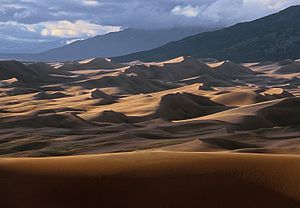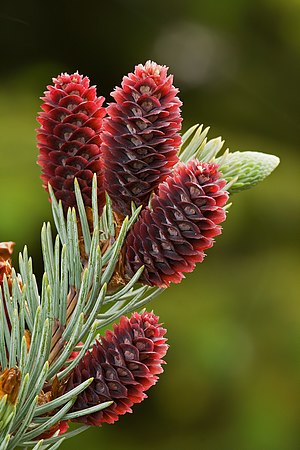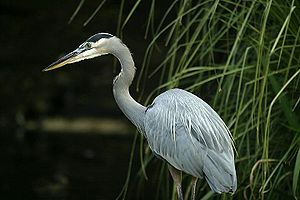Back from another two nights at Hawk Springs State Recreation Area. Again, the mornings and evenings were cool and wonderful, while the afternoons were hot. A quick dip in the lake took care of that. The second time hitching, unhitching, popping up and popping down was easier than the first, as expected. The big difference this time: I managed to sleep in the middle of the bed, after more aggressively pushing Tango to the side.
I spend some of my time identifying birds. I have all the field guides, including Peterson’s, Western Birds, but precious little recall when it comes to identifying birds. I remember all the big and exotic birds: Sand Hill Crane, Great Blue Heron, White Pelican, all the common birds: Robin, Blue Jay, Dove, and all the ugly birds: Crow, Grackle, Vulture, but never the smaller birds. It seems to me that those smaller birds are all brown and grey, each indistinguishable from the next. I wonder when I see one, is it a wren, warbler, or sparrow? The shorebirds are equally perplexing. Of course I can spot a seagull, and I recognize its call, but I am lost when choosing between a sandpiper and a snipe. Nothing is worse, though, than identifying a soaring hawk , which is any combination of dark, light, small, large stripped, mottled. Since I am not willing to keep my nose in a bird field guide all the time, I have decided to be content knowing that they are hawks, big, bold, and in our area, feathers bearing ruddy tones. An accomplished birder can identify birds by their beak, tail feather markings, wing bars, eye rings and breast colors. The beak of a seed-eater, like a sparrow, is different from a fly catcher. A common blackbird can be distinguished from a red-wing black bird by those red wing bars. The green head distinguishes a common loon from a red-throated loon. The gifted also know each bird song. As for me, I remember songs even less than the feather markings and beak shape.
An accomplished birder can identify birds by their beak, tail feather markings, wing bars, eye rings and breast colors. The beak of a seed-eater, like a sparrow, is different from a fly catcher. A common blackbird can be distinguished from a red-wing black bird by those red wing bars. The green head distinguishes a common loon from a red-throated loon. The gifted also know each bird song. As for me, I remember songs even less than the feather markings and beak shape.
About 4 years ago, I observed an elderly gentleman walking with his grandson near bushes along the perimeter of Great Sand Dunes National Park campground. Upon hearing a bird song, he knew what was in the bushes before he ever saw a feather. I heard him say fondly to his grandson, “Ahhh, a double-crested rosy bush tit,” or whatever. I don’t remember the actual name.

Great Sand Dunes National Park and Preserve (Photo credit: Wikipedia)
Part of my problem is that my head is filled with plant identification minutia. I have no problem determining among wildflowers which one is in the pea, rose, or mustard families. In my garden, I can distinguish between a cabbage and kohlrabi seedling. In the forest, I know a lodge pole pine from a Douglas Fir and, a Colorado Blue Spruce from a Northern White Cedar. From a long distance, I can see that a tree is clearly a peach and not an apple.

English: Young cones of a Colorado Blue Spruce (Picea pungens) (Photo credit: Wikipedia)
But, I want more than plant taxonomy in my mind’s recesses. I want to be like the elderly gentleman, strolling casually and greeting each bird knowingly, confidently. Birds are animals, with brains and the ability to talk back should I get too close to the nest. So, I halfheartedly browse those bird field guides, wishing I could master bird species without so much effort. Like humans, though, there is great variation in the features of individuals. In Texas, one species whose name I can’t remember has a black tuft, while the same bird in Wyoming does not. Also like humans, the birds change as they grow from newborn to adult and sometimes change again in different seasons. A breeding male lark bunting is dark with wing patches, while a female is brownish and a juvenile, fuzzy and nondescript. In contrast, the leaf structure for a member of the pea family will always look the same.
Because of the inherent variations, each bird field guide has photos with that can look completely different from the other book; this makes identification even more frustrating. Therefore, a birder wannabe must have several books, including at least one regional guide, like Western Birds and another more specific to a region, such as Birds of Colorado, which is my first stop when birding. Yes I live in Wyoming, but the Colorado birds, 80 miles to the south, do not understand borders and we offer much of the same habitat: treeless prairies to the east and the rugged Rocky Mountains to the west. I also have both a bird app on my Kindle with wonderful photos that covers a wide region and MP3s with bird sounds.
Still, bird identification is quite an art that require lots of field time and study. For now, I am happy to learn a bit more each year and take delight in just seeing the birds and hearing their songs, even if i can’t remember who the heck they are.
My Current Bird List: Hawk Springs State Recreation Area
- White Pelican
- Canada Geese
- Great Blue Heron
- Night Hawk
- Prairie Falcon
- Sea Gull
- Lark Bunting
- Tiny bird with yellow belly that I have not identified
- Dove-like bird
- Brownish small bird that looks like hundreds of other species

Great Blue Heron (Photo credit: Wikipedia)
Related articles
- Bird-brained (27thstreet.wordpress.com)
- The Top Five Phoenix Birds (local.answers.com)


